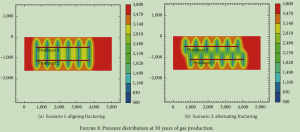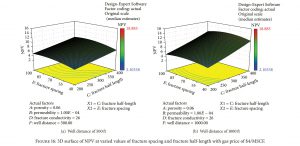Optimization of Multiple Hydraulically Fractured Horizontal Wells in Unconventional Gas Reservoirs
Abstract
Accurate placement of multiple horizontal wells drilled from the same well pad plays a critical role in the successful economical production from unconventional gas reservoirs. However, there are high cost and uncertainty due to many inestimable and uncertain parameters such as reservoir permeability, porosity, fracture spacing, fracture half-length, fracture conductivity, gas desorption, and well spacing. In this paper, we employ response surface methodology to optimize multiple horizontal well placement to maximize Net Present Value (NPV) with numerically modeling multistage hydraulic fractures in combination with economic analysis.
This paper demonstrates the accuracy of numerical modeling of multistage hydraulic fractures for actual Barnett Shale production data by considering the gas desorption effect. Six uncertain parameters, such as permeability, porosity, fracture spacing, fracture half-length, fracture conductivity, and distance between two neighboring wells with a reasonable range based on Barnett Shale information, are used to fit a response surface of NPV as the objective function and to finally identify the optimum design under conditions of different gas prices based on NPV maximization. This integrated approach can contribute to obtaining the optimal drainage area around the wells by optimizing well placement and hydraulic fracturing treatment design and provide insight into hydraulic fracture interference between single well and neighboring wells.




